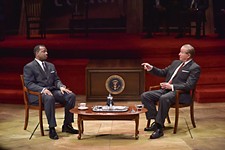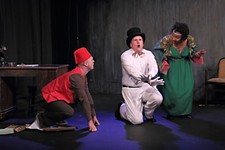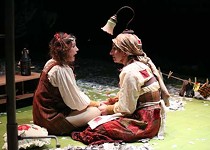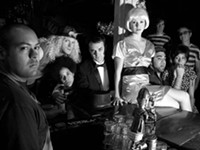A Man for All Seasons
In Austin Playhouse's 'A Man for All Seasons,' David Stahl's immaculate Sir Thomas More stands his moral ground with humility, humor, and insight
Reviewed by Patti Hadad, Fri., Oct. 21, 2005

A Man for All Seasons
Austin Playhouse, through Nov. 6
Nothing in the world of modern thought is debated more than moral issues, and voicing one's opinion is expected, even demanded. So it's a rarity to find a man who will risk losing his home, family, friends, and even his head to remain quiet on a matter of morals, without so much as a "no comment."
Robert Bolt's 1960 drama A Man for All Seasons is a staged moral debate on Sir Thomas More's silence. If you know your history, you'll recall that King Henry VIII started the Church of England when Rome rejected his divorce of Catherine of Aragon, who hadn't provided him with any heirs, so he might marry his mistress Anne Boleyn. Bolt's drama is a long, drawn-out clash of wills between the Catholic More, who refused to surrender his convictions regarding the king's actions, and everyone else, who insisted that he do so.
In the Austin Playhouse production, David Stahl's immaculate More engages in these conflicts with humility, humor, and insight. It's hard to tell if the cast is naturally moving or if the other actors are better for being onstage with Stahl. With the best one-liners of all the characters, he creates a More who is witty, charming, and loved by all. The only other comic relief of the show is veteran Dirk van Allen's Common Man, who comes off as more of a baggy-pants quipster than the point-of-view cynic Bolt intended him to be.
The show opens warmly among friends drinking wine: pupil Richard Rich (Michael A. Danburg), the Duke of Norfolk (Gray G. Haddock), More's wife, Alice (Janet Hurley Kimlicko), and daughter Margaret (Lara Toner). They are dressed for refinement; Buffy Manners' ornate Tudor costumes, heavy with velvets, bullion, and coifs, put the characters decorously in the 16th century and upstage the less noble gray set.
When the young athletic King (Brian Coughlin), wearing his wealth in fur and gold, visits his friend More to coerce him into taking his side on the divorce, More switches from mighty father figure to a picture of obsequiousness as the king's servant. But when faced with others, More's fights are ferocious. His obstinacy extends to the duke and even to the Spanish ambassador, Signor Chapuys (Barry Miller), while his friends have trouble comprehending that More is trying to protect his conscience rather than broadcast his spiritual beliefs. One out-of-place adversary is More's son-in-law, William Roper (David Higgins), who comes off as more of an Everyman than the play's Common Man, poking and prodding More's intellectual and spiritual standing with questions rather than opposing it.
Guy Roberts, disguised in dark hair, diabolically slithers from the shadows as Cromwell, More's nemesis. His wheedling interrogation aggravates the audience's empathy for More. Mark Novick's effective lighting draws on the characters more than on location: More stands alone in a brilliant white light, Cromwell festers in soft candlelight. The final act as More says his farewell to his wife, you see Kimlicko as Stahl's lioness, squabbling about little things and moving the audience to tears as he pleads for her not to hate him. Director Don Toner's commitment to Bolt's play balances the bulk of monarchial abuse of power with commonality and faith.










